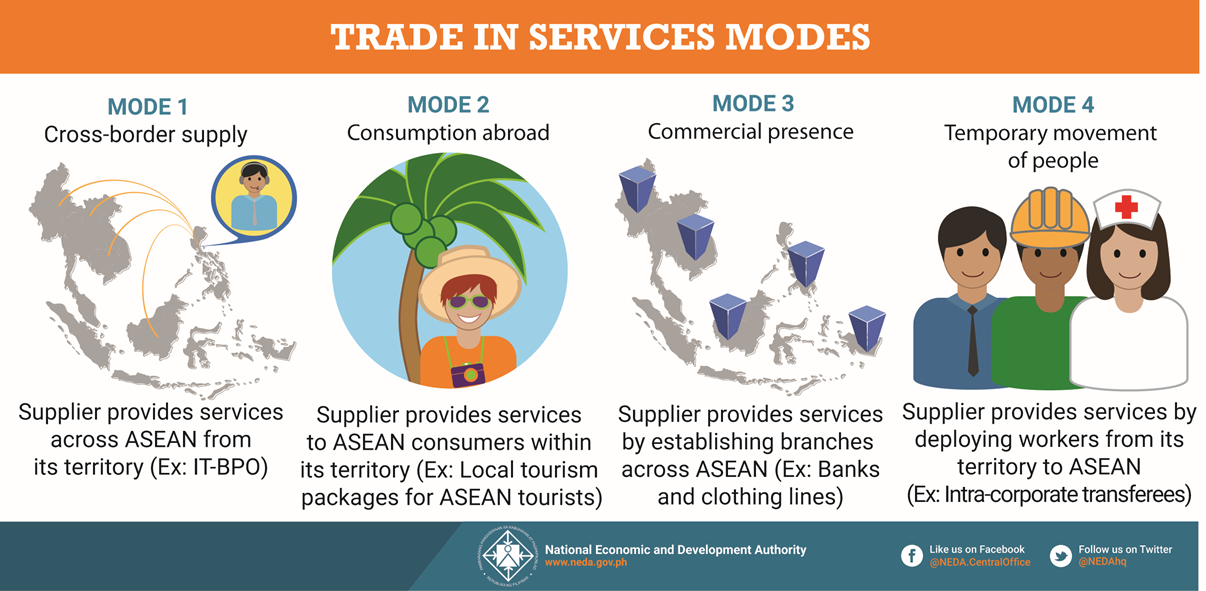The ASEAN Economic Community (AEC) envisions the region to become a significant player in global trade by having a single production and market base within the ASEAN. This means that firms and individuals can freely transact business across countries within the region without being subjected to too many country rules, procedures, and duties.
Regional economic integration offers opportunities for the Philippine labor market, if the country eliminates restrictions that currently impede the flow of services and goods.
Trade in services
Trade in services is categorized into four modes: (1) cross-border supply, (2) consumption abroad (3) commercial presence; and (4) temporary movement of people (see infographics below on “Trade in services modes”). By the end of 2015, there will be no restrictions for Modes 1 and 2 as stated in the AEC Blueprint. For Mode 3, a maximum of 70 percent foreign (ASEAN) equity participation is allowed in establishing commercial presence within the region.

(More details on Mode 4 are discussed in the article “’Skills challenge’ seen with free flow of ASEAN professionals.”)
Free flow of services is expected to increase investments and create more jobs, said Ramonette Serafica, Research Fellow of the Philippine Institute for Development Studies (PIDS). But for ASEAN suppliers to invest in the Philippines, Serafica said we need to improve infrastructure and eliminate further restrictions to strengthen our competitiveness.
 “For example, the transportation and communication sectors, which are covered by the 60-40 Filipino-foreign) equity rule, have low employment and negative labor productivity growths. If foreign investments are able to flow into these sectors, more workers could be employed across a range of skill levels,” she said.
“For example, the transportation and communication sectors, which are covered by the 60-40 Filipino-foreign) equity rule, have low employment and negative labor productivity growths. If foreign investments are able to flow into these sectors, more workers could be employed across a range of skill levels,” she said.
As to commercial presence in the region, Filipino firms are already “ASEAN-engaged” and not lagging behind, said former Socioeconomic Planning Secretary Cielito Habito. He added that local small and medium enterprises (SMEs) need to cluster together to be successful.
“SMEs are encouraged to team up to accommodate volume of orders in the ASEAN,” said Habito, adding that the Department of Trade and Industry has pushed for shared service facilities that allow small producers to use them together.
Trade in goods
Almost all products are already freely traded in ASEAN, with tariffs as low as 0-5 percent as of 2010. In 2013, 16 percent of Philippine exports were sent to ASEAN, while 22 percent of imported goods came from ASEAN.
Sensitive agricultural products, including rice, are the remaining goods that need to be liberalized. Habito said the Philippines needs to be more open and start looking at approaches toward attaining food security at the regional level.
“We can have the greater Mekong Delta as the rice granary of AEC, as long as there is clear commitment that rice will be readily available to any other ASEAN country,” he said.
PIDS President Gilberto Llanto noted that there are sporadic successes of small rice farmers transitioning to high value crops and being linked to the food chain industry.
Llanto said one other approach is for farmers to target minimarts or grocery stores that are now sprouting in growth centers. A group of farmers can collaborate so that they can regularly supply goods to be sold in these minimarts.
“Understanding the way the industry is organized should help farmers organize themselves. These are the things that need to be addressed in our labor market,” he said.
Click here to download a PDF copy of the NEDA DevPulse Vol. 17 No. 1 2nd Semester 2014 issue.



